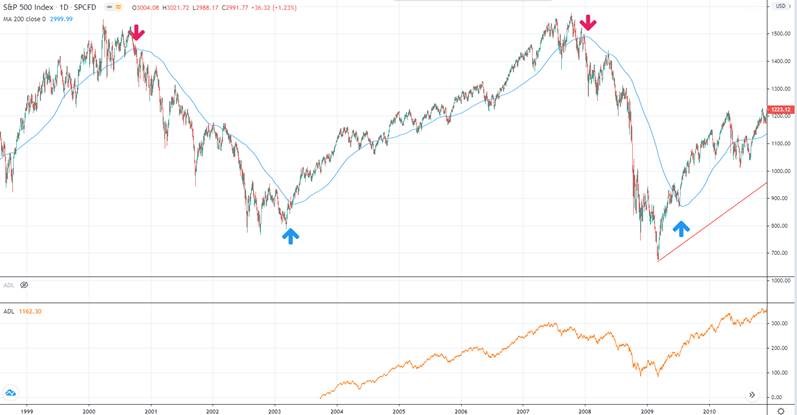
Wednesday May 27 2020 08:07

6 min
US shares surged on Tuesday, with the Dow rising more than 2%, briefly trading above the 25k level again before closing a little short. The S&P 500 rose over 1%, traded above 3,000 for the first time since March 5th hitting a high at 3,021 before it too closed below this psychologically important level. The broad index traded above the important 200-day moving average but failed to close above this indicator.
Economies continue to reopen a little quicker than we’d feared. US airlines are reporting a uptick in passenger levels vs where they were last month, but were down about 80% from the same Memorial holiday weekend a year before. Globally, it seems as though countries are able to ease lockdown restrictions without sparking immediate secondary waves of infections – albeit the risk of such emerging down the line should not be ignored.
The higher the S&P 500 rises without earnings picking up the pricier it gets. PE multiples already look stretched and further gains for the index would come despite declining earnings, stretching these valuations still further. What happens when banks really lay bare all the non-performing loans they are going to need to write off?
In the last two major recessions (see below chart), the 200-day simple moving average has been the ceiling for the market. A breakout here would be important for recovering market highs – failure could suggest it will contain price action for a while. I hate to say it but this time could be different – central bank largesse was not a factor like it is today. This only concentrates the power of the largest capitalised companies.
What’s going on in the real economy is not reflected by markets. Even as we reopen, the economic uncertainty and long-term health fears will support household deleveraging, boost savings rates and knock consumer spending.
Today the Fed will release its Beige Book providing anecdotal evidence of business activity across the US – there will be some very grim stories to tell and will underline how it will take a long time to get businesses and people moving at the same rate they were before the crisis.
The rally in global equities seen at the start of the week ran out of steam a little in Asia overnight though as tensions in Hong Kong hove into view once more. Riot police fired pepper pellets at groups gathering to protest a bill that would ban people from insulting the Chinese national anthem. This comes as tensions were stoked by China’s planned introduction of sweeping national security powers in Hong Kong.
There is a strong chance that the anti-Beijing feeling grows and leads to the kind of unrest we saw over several months last year. The US is said to be considering sanctions against China; Beijing said yesterday it was increasing its readiness for military combat. Whilst the eyes of the world are on Hong Kong, China is already engaged in a military standoff on its border with India.
Asian shares fell broadly, although Tokyo held up as Japan said it will carry out another $1.1 trillion stimulus package on top of a $1.1tn programme already launched last month. The Hang Seng dipped by almost 1%. But European shares rose with the FTSE 100 recapturing 6100 and making a sally towards 6200 and to close the early March gap.
Yesterday the DAX made the move back towards its Mach 6th close at 11,541 to fill the gap but failed to complete the move on the close. This morning the DAX moved strongly through this level after a pause at the open, moving back to 11,600.
In FX, both the euro and pound failed to really make any real breach despite a strong gain yesterday and have come off their highs. EURUSD moved back towards the middle of the recent range, having fallen short of a move back to 1.10 and was last trading around 1.0960. GBPUSD has retreated under 1.23 having fallen short of the 50% retracement of the move lower over the last month around 1.2375.
After Germany and France proposed a €500bn bailout fund based on mutual debt issuance (what some have dubbed Europe’s Hamiltonian moment), EC President Ursula von der Leyen will present her plans, which will build on the Franco-German proposal and call for a €1 trillion plan. If the budget talks are successful it should lower the risk premium on EU sovereign debt, lowering bond yields and offering succour to the euro as well as to European equity markets. It would also mark a major step towards EU fiscal policy coordination and possible fiscal union. The frugal four remain a hindrance but Merkel’s weight is behind this.
We’re also looking at the appearance before MPs today by Michael Gove and UK Brexit negotiator David Frost.
Gold was weaker, testing $1700 again as US yields rallied on economic reopening, but 10yr Treasury yields peeled back off the highs at 0.7% due perhaps to the US-China tension.
WTI (Aug) has retreated further from the $35 level and is testing support around $34. The pattern suggests a pause for thought as we try to figure out the mess of supply and demand. The pattern is one of consolidation with a bullish flag forming, with better demand forming the basis for the move alongside supply impairment that was evidenced by a new report from the IEA saying Covid-19 will cause investment in the energy sector to decline by $400bn this year. That is the kind of capex carnage that will remove a lot of supply and force rebalance quickly.

